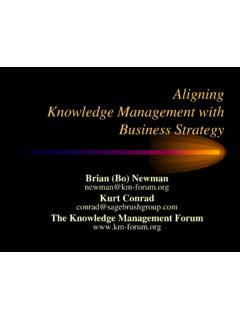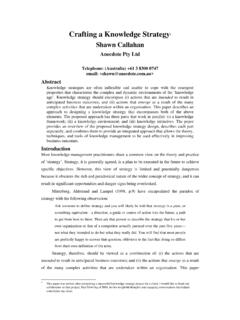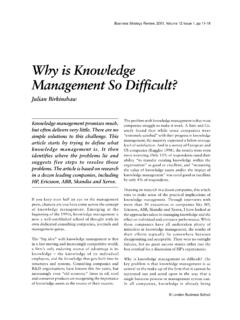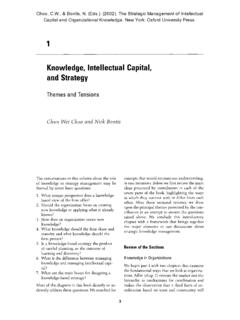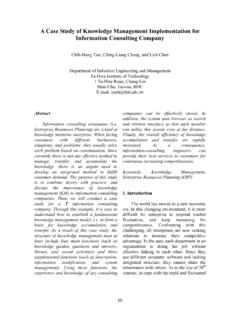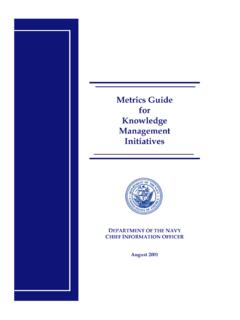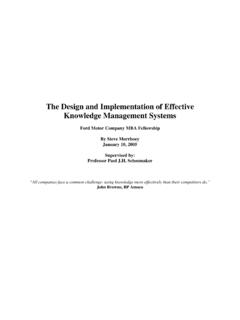Transcription of How to create, evaluate, and improve your KM strategy over ...
1 Page 1 of 5 Research provided by APQC, the international resource for benchmarks and best practices K03959 2012 APQC. ALL RIGHTS RESERVED Developing a knowledge strategy That Senior Leaders Can Get Behind How to create, evaluate, and improve your KM strategy over time 15 years ago when knowledge management was still a new idea, companies launched knowledge management (KM) programs based solely on vision and promise. But in a climate that increasingly emphasizes productivity and effectiveness in all aspects of business, KM is not exempt from scrutiny.
2 To receive support and funding, your KM program must be founded on a solid strategy and business case that demonstrate a deep understanding of your organization s critical knowledge needs. Despite strategy 's role as a fundamental building block, many organizations still struggle with or neglect this component of their programs. When APQC polled an audience of KM practitioners in 2011, more than half said that their organizations either didn't have business cases for KM or that their business cases weren't adequate for their needs (Figure 1). How Well Is Your Organization s Business Case for KM Working?
3 Figure 1 Even those who know they need to improve their strategies often go about it the wrong way. Clients routinely come to APQC and say, "My business unit wants to implement communities of practice. Can you help us build a strategy around that?" Their intentions are good, but selecting don t have one yetNot quite good enoughGreatPoorN=131N=131 Page 2 of 5 Research provided by APQC, the international resource for benchmarks and best practices K03959 2012 APQC. ALL RIGHTS RESERVED a KM approach like communities before you know what you're trying to achieve is a bit like a doctor prescribing medicine before coming up with a diagnosis.
4 You have to define the problem before you design the solution. S T AR T B Y ASKI NG " WHY?" When building a knowledge strategy and business case, the first step is to determine why you're pursuing KM in the first place. What problem is the organization trying to solve, and what advantages will knowledge -sharing tools and approaches provide? You should look closely at your organization's strategic goals and talk to executives about what's keeping them up at night. The following five questions can guide your conversations with senior leaders and focus attention on the right problems and opportunities.
5 1. Does the current available knowledge allow us to compete in the near term? 2. What knowledge will we need to innovate and meet longer-term customer needs? 3. What market differentiator(s) can be improved if knowledge and expertise are better shared and transferred? 4. Are there current and pending challenges or issues that are knowledge -related? 5. What does success look like for a KM endeavor? The answers to these questions will help you define the reasoning behind your KM program along with leadership expectations, near- and long-term opportunities, and potential challenges.
6 This, in turn, will point you toward the right KM tools and approaches. For example, if your organization is vulnerable to knowledge loss due to retirements, mergers, or downsizing, you may want to develop approaches to capture and retain that critical knowledge . But if your organization is expanding, it may make more sense to focus on virtual communities that connect new hires to experts and expertise. No matter what your organization's knowledge goals are, you must ensure that the KM tactics being implemented are linked to targeted objectives and aligned with your organization s overall strategic direction.
7 C RE AT E A P L AN O F AC TIO N Once you've established the purpose behind your KM program and the knowledge -sharing approaches most likely to support your goals, the next step is to articulate a business case. A good business case answers the same who, what, when, where, why, and how questions that characterize all informative writing. Explain exactly what you propose to do, why it's important, and how you'll get it done. List the people and resources involved, describe the benefits and risks, and lay out a timeline with clear milestones.
8 Your leaders are more likely to support your proposal if you back it up with solid data and realistic estimates. Page 3 of 5 Research provided by APQC, the international resource for benchmarks and best practices K03959 2012 APQC. ALL RIGHTS RESERVED APQC recommends clearly defining the reach of your program. While it s possible to build a business case for KM at the local level, this strategy does not help build capacity for the future. You need a centralized foundation for replicable models that will help you avoid redundant efforts. ( Design once, use again is the mantra of the best KM programs.)
9 Make the case for an enterprise KM program with standardized approaches, not a loose collection of local, unscalable KM initiatives. Your business case should also emphasize how the organization will profit from knowledge sharing and collaboration. Instead of making vague claims or enumerating every potential benefit of KM, hone in on the specific goals and problems you identified earlier. Be sure to emphasize how knowledge will be used, not just how it will be captured and shared. No matter how much knowledge an organization documents, it does not benefit until that knowledge is used to innovate, improve products and services, reduce costs, shorten cycle times, and so on.
10 Hard numbers can make your business case more compelling, so be sure to assign dollar values to your inputs, the outputs you expect, and the projected impact of KM on productivity and revenue. But as you make your estimates, remember that all KM approaches especially those with IT components require maintenance, regular updates, and staff support. If you want your ROI calculations to pan out, assess your current IT capabilities to ensure that anticipated KM support costs are realistic. ME ASU RE AND V AL I D ATE OV E R T IME Once your program is up and running, you must prove that your KM tools and approaches actually do what you hypothesized they would.





